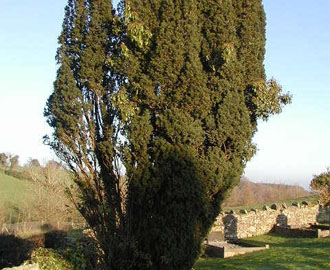
For many centuries, the pleasant village of Overton was located in Maelor Saesneg (English Maelor), a part of Flintshire entirely surrounded by English territory. It is now in the county of Wrexham. On the way from Chester to Overton, via Wrexham, visitors should stop at Bangor-Is-Y-Coed (Bangor-on-Dee), whose 17th century bridge is said to have been designed by the famed architect Inigo Jones, and where one of the very earliest monasteries in Britain was founded in the fifth century. After the English defeat of the Welsh at the Battle of Chester in 616, the English king Aethelfrith (Ethelfrid) ordered the slaughter of the monks at Bangor-Is-Y-Coed, many of whom fled to Ynys Enlli (Bardsey Island), off the Ll?n Peninsular. The king is said to have asserted that praying against him was as bad as fighting against him. According to the English historian Bede, who was very biased against the Welsh and the Celtic Church, over 1200 monks were killed, and the monastery destroyed. As a result of the battle, the Welsh in Wales were cut off from their compatriots in Cumbria, now part of northern England. Thus the history of Wales as a separate nation can be said to date from this time.
At Overton, St. Mary's Church dates only to the 13th century, though there may have been a small Christian oratory on the site as early as the seventh century. One of the oldest features of the church is a Norman circle cross built into the western pillar of the Nave. On another pillar by the pulpit is an unusual brass processional cross that was brought back from Abyssinia by British soldiers in the 19th century. Rescued from a scrap pile in that unfortunate country, the inscribed cross may date to the sixth century. Some of the 21 famous yew trees in the churchyard date back at least to the 12th century, when the first stone church was erected.
Perhaps the yew tree, which begins again with new roots after the older tree has rotted away and therefore lasts for many centuries, has a pre-Christian tradition. It is certainly difficult to ascertain the importance to Welsh history of the Overton yew trees and their inclusion in the nursery rhyme unless one considers the honoured place of Welsh mercenary soldiers in the armies of England. Yew's elastic properties made it the ideal wood for the longbow, for over three centuries the main weapon of the English army. The English King Edward I is said to have decreed that yews trees should be planted in all English churchyards to provide a plentiful supply of wood for the longbow. To effectively utilize its power, a large body of archers was recruited in Wales, a country with a long military tradition, and where the longbow may have been first developed. In the 14th century, these soldiers were paid six pence a day, much more than they could ever have earned on the farms or in the mills in their home villages.
Even during the years of Prince Llewelyn ap Gruffudd's brief rule over an independent Wales, as many as nine thousand Welsh archers were fighting for Edward I in his 1277 campaign to conquer the stubborn principality. After the Conquest, Wales had many more soldiers available to fight for a cause other than that of their native country, and they were heavily recruited by English kings. Welsh archers were prominent in the Battles of Falkirk in 1298 and Bannockburn in 1314 against the Scots, and were especially noticeable in the great victory over the French at Crecy in 1346, where they were dressed in green and white, and where the tradition of wearing a leek may have originated. Perhaps their greatest day of glory came at Agincourt, in 1415, when the skill of the Welsh archers helped the rag-bag army of Henry V to completely annihilate the flower of the French army. Such was the demand for skilled archers to serve in the armies of the Crown that in 1483 Richard ll ordered a general planting of yews to provide the wood for their longbows.
點(diǎn)擊查看本頻道更多精彩內(nèi)容